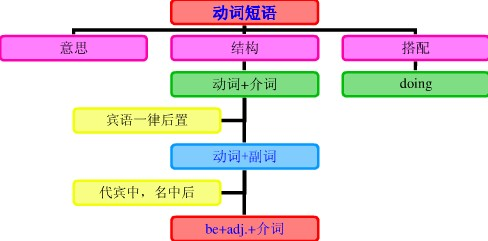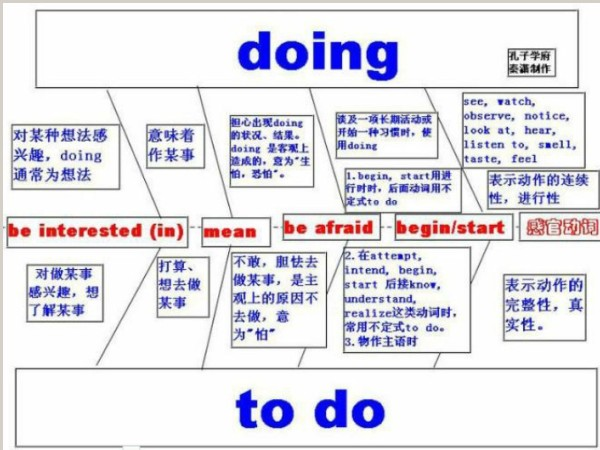本试题 “He felt lonely in the first month abroad,but after a time he got ____ alone and even got ____ it.[ ]A. used to living; to enjoyB. used to live; to ...” 主要考查您对动词短语
动名词
不定式
等考点的理解。关于这些考点您可以点击下面的选项卡查看详细档案。
- 动词短语
- 动名词
- 不定式
动词短语的概念:
动词常和某些其他词类用在一起,构成固定词组,形成所谓短语动词(phrasalverb)。和动词一样,短语动词也可分为及物和不及物两种。短语动词可以作为一个整体看待,同一般动词一样使用。
动词短语的搭配类型:
1)动词+介词:这类短语动词用作及物动词,后面须跟宾语。
如:The small boy insisted on going with his parents. 那男孩坚持要跟父母一起去。
Do you often listen to broadcasts in English? 你常听英语广播吗?
Look at the children. Aren't they lovely? 看着这些孩子们。他们多么可爱呀!
We stand for self-reliance. 我们是主张自力更生的。
这一类的短语动词还有很多,如depend on(upon)(依靠),wait on(服侍),look for(寻找),deal with(对待),look after(照料),wait for(等待)等。
2)动词+副词:
这类短语动词有的用作及物动词,有的用作不及物动词。
如:I always get up as soon as the bell rings. 我总是一打铃就起床。(不及物)
Look out, there's a car coming! 当心,来汽车了!(不及物)
Have you handed in your exercises already? 你已经交练习了吗?(及物)
Please don't forget to put on your coat, it's cold outside. 请不要忘记穿外衣,外面很冷。(及物)
这一类的短语动词还有很多,及物如put out(扑灭),eat up(吃光),put down(放下);不及物如set off(出发),come up(走近),go on(继续)。
注:"动词+副词"这类短语动词和上面第一类"动词+介词"的不同之处在于:"动词+介词"用作及物动词,后面须跟宾语。"动词+副词"则有的及物,有的不及物;用作及物动词而宾语为人称代词或自身代词时,副词往往放在宾语之后。
如:Please wake me up at five tomorrow. 请在明天早上五点唤醒我。
If you have done your exercises, please hand them in. 如果你们练习做完了请交来。
She doesn't normally behave like that, she's putting it on. 她通常并不如此表现,她是装出来的。
注:这类短语动词有不少可兼作及物和不及物动词用。
如:He took off his hat when he entered the office. 他进办公室后脱下帽子。(及物)
The plane took off at seven sharp. 飞机在七点整起飞。(不及物)
Charlie rang up Neil to ask about the time of the meeting. 查理打电话给尼尔问开会的时间。(及物)
If you can't come, please ring up and let us know. 你如来不了,请来电话告诉我们一声。(不及物)
3)动词+副词+介词:
"动词+副词"之后有的可以再加一个介词,形成另一种短语动词。这类短语动词用作及物动词。
如:Do not give up hope. We must go on with the experiment 不要失望。我们必须继续试验。(go on with继续)
He came up to me. 他走到我跟前。(come up to走近)
这类短语动词还有:look down upon(看不起),do away with(去掉),put up with(忍受)等。
4)动词+名词+介词:
这类短语动词也是及物的。
如:He shook hands with all the guests at the banquet. 他在宴会上和宾客一一握手。
Young pioneers often come to the Children's Palace to take part in after school activities.少先队员经常到少年宫来参加课外活动。
Pay attention to the temperature of the stored rice. 注意仓库里的稻谷的温度。
Her job is taking care of the babies. 她的工作是照顾婴儿。
这一类短语动词还有:put an end to(结束),take notice of(注意),catch hold of(抓住),lose sight of(看不见),make use of(利用)等。
动词短语知识体系:

动名词概念:
动名词是一种兼有动词和名词特征的非限定动词。它可以支配宾语,也能被副词修饰,动名词有时态和语态的变化。
现在分词和动名词用法比较:
动词的-ing形式包括现在分词和动名词两种形式。他们的句法功能如下:
动词的-ing形式如果作句子的主语或者宾语时,应该是动名词形式;如果作补语或者状语时,应该是现在分词形式。那么作表语或者定语的动名词和现在分词又该怎样区分呢?
1、动名词与现在分词作表语时的比较:
(1)动名词作表语说明主语的内容,回答what的问题;现在分词作表语相当于形容词作表语,说明主语的性质、特征等,回答how的问题。
如:One of the best exercises is swimming. 游泳是最好的运动项目之一。
What pleases him most is bathing in the sea. 最使他高兴的事是在海中沐浴。
The situation both at home and abroad is very in-spiring. 国内外的形势都很鼓舞人心。
The color is pleasing to the eye. 颜色悦目。
(2)动名词作表语,表语和主语几乎处于同等地位,可以互换位置,其句意不变;现在分词作表语,表语和主语则不能互换位置。
如:Our work is serving the people.
(=Serving the people is our work.)我们的工作是为人民服务。
The news was disappointing. 那消息令人失望。
(3)作表语的现在分词前可以用very,quite,rather,greatly等副词修饰,而动名词则不可以。
如:What he said was very encouraging. 他的话很鼓舞人心。
Our goal is realizing the four modernizations in the near future. 我们的目标是在不久的将来实现四个现代化。
(4)现在分词与形容词一样可以和more,the most构成形容词的比较级和最高级,而动名词则不可以。
如:The story is the most fascinating. 那个故事最迷人。
(5)作表语用的现在分词除了和be连用以外,还可以和其它的系动词连用;而作表语的动名词则通常只能和be连用。
如:His speech seems inspiring.他的演讲似乎很鼓舞人心。
His interest is writing for the news papers. 他的爱好是给报社写文章。
(6)有些用作表语的现在分词已经形容词化了。常见的有:exciting,moving,inspiring,missing,interesting,disappointing等。
2、动名词与现在分词作定语时的比较:
(1)动名词作定语时,表示它所修饰的名词的性能和用途,和它所修饰的名词在逻辑上没有主谓关系;
现在分词作定语时,表示它所修饰的名词正在进行的动作,和它所修饰的名词在逻辑上有主谓关系,常可以扩展成一个定语从句。
如:a swimming girl=a girl who is swimming 一个在游泳的姑娘
a walking stick=a stick that is used for walking 一根拐杖
(2)现在分词作定语有时可以后置,而动名词则通常只能放在它所修饰的名词之前。
如:The girl wearing glasses is one of his students. 戴眼镜的那个女孩是他的一个学生。
I bought some reading materials. 我买了一些阅读材料。
动名词的用法:
1、作主语:
例如:Fighting broke out between the South and the North. 南方与北方开战了。
2、作宾语:
a. 有些动词可以用动名词作宾语。
例如:admit承认 appreciate感激 avoid避免 complete完成 consider认为 delay耽误 deny否认 detest讨厌 endure忍受 enjoy喜欢 escape逃脱 fancy想象 finish完成 imagine想象 mind介意 miss想念 postpone推迟 practice训练 recall回忆 resent讨厌 resume继续 resist抵抗 risk冒险 suggest建议 face面对 include包括 stand忍受 understand理解 forgive宽恕 keep继续
例如:Would you mind turning down your radio a little, please? 你把收音机音量调小一点,好吗?
The squirrel was lucky that it just missed being caught. 这松鼠幸运得很,刚逃避了被逮住的厄运。
b. 有些结构后面可以用动名词作宾语或其他成分。
例如:admit to prefer...to burst out keep on insist on count on set about put off be good at take up give up be successful in be used to lead to devote oneself to object to stick to no good no use be fond of look forward to be proud of be busy can't help be tired of be capable of be afraid of think of
3、作表语,对主语说明、解释:
例如:Her job is washing, cleaning and taking care of the children. 她的工作是洗刷、清扫和照顾孩子。
比较:She is washing, cleaning and taking care of the children.
4、作定语,一般表示所修饰名词事物的用途:
例如:a writing desk=a desk for writing 写字台
a swimming pool=a pool swimming 游泳池
有些动名词作定语,与所修饰的名词关系比较复杂。
例如:boiling point=a temperature point at which something begins to boil 沸点
a walking tractor=a tractor which a driver can operate while he or she is walking behind it 手扶拖拉机
动名词知识体系:

动名词与不定式用法对比:

动词不定式的概念:
动词不定式指由to加上动词原形(而且只能是动词原形)所构成的一种非限定性动词,但在有些情况下to可以省略。动词不定式在语法功能上可作主语、宾语、宾语补足语、
表语、定语和状语。
不定式的特殊句型对比:
1、不定式的特殊句型too…to…:
1)too…to 太…以至于…。
例如:He is too excited to speak. 他太激动了,说不出话来。
—Can I help you? 需要我帮忙吗?
—Well, I'm afraid the box is too heavy for you to carryi t, but thank you all the same. 不用了。这箱子太重,恐怕你搬不动。谢谢。
2)如在too前有否定词,则整个句子用否定词表达肯定,too后那个词表达一种委婉含义,意为“不太”。
例如:It's never too late to mend. 改过不嫌晚。(谚语)
3)当too前面有only, all, but时,意思是:非常…等于very。
例如:I'm only too pleased to be able to help you. 能帮助你我非常高兴。
He was but too eager to get home. 他非常想回家。
2、不定式的特殊句型so as to:
1)表示目的:它的否定式是so as not to do。
例如:Tom kept quiet about the accident so as not to lose his job. 汤姆对事故保持沉默是为了不丢掉他的工作。
Go in quietly so as not to wake the baby. 轻点进去,别惊醒了婴儿。
2)表示结果:
例如:Would you be so kind as to tell me the time? 劳驾,现在几点了。
3、不定式的特殊句型:Why not:
“Whynot+动词原形”表达向某人提出建议,翻译为:为什么不……? 干吗不……?
例如:Why not take a holiday?
不定式的用法:
1、不定式作补语:
1)有些有动词+宾语+不定式的结构。
例如:advise allow cause challenge command compel drive驱使
enable encourage forbid force impel induce instruct invite like/love order permit make let have want get warn persuade request send tell train urge 等。
例如:Father will not allow us to play on the street. 父亲不让我们在街上玩耍。
The officer ordered his men to fire. 长官命令士兵开火。
注意:有些动词如make,have,get,want等可用不定式作做宾补,也可用分词作宾补。现在分词表达主动,也表达正在进行,过去分词表达被动。
2)有些有动词+宾语+不定式的结构,不定式的动词往往是be,不定式一般可以省去。
例如:consider find believe think declare(声称) appoint guess fancy(设想) guess judge imagine know 等。
例如:We believe him to be guilty. 我们相信他是有罪的。
We know him to be a fool. 我们知道他是个笨蛋。(tobe不能省去)
典型例题:Charles Babbage is generally considered___the first computer.
A. to invent
B. inventing
C. to have invented
D. having invented
答案:C. 一般没有consider+宾语+be以外不定式的结构,也没有consider+宾语+doing的结构,排除A、B、D。consider用动词be以外的不定式作宾补时,一般要求用不定式的完成式,故选C。 3)有些动词可以跟there+to be的结构。例如:believe expect intend like love mean prefer want wish understand 等。
例如:We didn't expect there to be so many people there. 我们没料到会有那么多人在那里。
You wouldn't want there to be another war. 你不至于想让另外一场战争发生吧。
2、不定式作主语:
不定式作主语,往往用it作形式主语,真正的主语不定式放至句子的后面。
例如:It's so nice to hear your voice. 听到你的声音真高兴。
It's necessary for you to lock the car when you do not use it. 不用车的时候,锁车是有必要的。
It's very kind of you to help us. 他帮助我们,他真好。
It seemed selfish of him not to give them anything. 他不给他们任何东西,这显得太自私了。
3、不定式作表语:
不定式可放在be动词后面,形成表语。
例如:My work is to clean the room every day. 我的工作是每天清扫房间。
His dream is to be a doctor. 他的梦想是成为一名医生。
4、不定式作定语:
不定式做定语通常要放在被修饰的词后,往往表示未发生的动作。
例如:I have a lot of work to do.我有许多事要做。
There was nothing to bring home that morning. 那天早上(他回家时)两手空空。
5、不定式作状语:
1)目的状语:常用结构为to do,only to do(仅仅为了), in order to do,so as to do,so(such)...asto…(如此…以便…)。
例如:He ran so fast as to catch the first bus. 他飞快地跑以便赶上第一班车。
I come here only to say good-bye to you. 我来仅仅是向你告别。
2)作结果状语,可以表示没有预料到的或事与愿违的结果,不定式要放在句子后面。
例如:I awoke to find my truck gone. 我醒来发现箱子不见了。
He searched the room only to find nothing. 他搜索了房间,没发现什么。
3)表原因:
例如:I'm glad to see you. 见到你很高兴。
She wept to see the sight. 她一看到这情形就哭了。
4)表示理由和条件:
例如:He must be a fool to say so.
You will do well to speak more carefully.
You will do well to speak more carefully.
不定式知识体系:

不定式用法拓展:
1、用作介词的to:
to可以用作介词,也可用作不定式的标示。下面的to都用作介词:admit to object to beaccus to med to beused to stick to turn to开始 look forward to be devoted to pay attention to contribute to apologize to devote oneself to
2、省去to的动词不定式:
1)情态动词(除ought外)后。
2)使役动词let,have,make后,感官动词see, watch, lookat, notice, observe, hear, listento, smell, feel, find等后。
注意:被动语态中不能省去to。
例如:I saw him dance. 我看见他跳舞。=He was seen to dance.
The boss made them work the whole night. 老板让他们整夜干活。 =They were made to work the whole night.
3)would rather,had better句型后:
4)Why…/why not…句型后:
5)help后可带to,也可不带to, help sb(to)do sth:
6)but和except后:
but前是实义动词do时,后面出现的不定式不带to。
比较:He wants to do nothing but go out. 他只想出去玩。
He wants to believe anything but to take the medicine. 除了吃这药,他什么都信。
7)由and, or和than连接的两个不定式,第二个to可以省去:
8)通常在discover, imagine, suppose, think等词后作宾补时,可以省去to be。
例如:He is supposed(to be)nice. 他应该是个好人。
3、动词不定式的否定式在不定式标志to前加上not。
例如:Tell him not to shut the window。让他别关窗。
She pretended not to see me when I passed by. 我走过的时候,她假装没看见。
4、It's for sb. 和It's of sb. 这样的句子中,由于表语形容词性质的不同,导致了不定式逻辑主语标志用for或of的区别。
1)for sb. 句型中的形容词一般为表示事物的特征特点,表示客观形式的形容词,如easy, hard, difficult, interesting, impossible等:
例如:It's very hard for him to study two languages. 对他来说学两门外语是很难的。
2)of sb句型中的形容词一般为表示性格,品德,心智能力,表示主观感情或态度的形容词,如good, kind, nice, clever, foolish, right。
例如:It's very nice of you to help me. 你来帮助我,你真是太好了。用for还是用of的另一种辨别方法:用介词for或of后面的逻辑主语作句子的主语,用介词前边的形容词作表语,造个句子。如果通顺用of,不通则用for。
例如:You are nice.(通顺,所以应用of)。
He is hard.(非所表达的意思,不通,因此用for。)
与“He felt lonely in the first month abroad,but after a time...”考查相似的试题有:
- I’ll never understand how it __________ that you were late three times a week.A.came up withB.came acrossC.came ab...
- 31. I tried to telephone you, but I couldn’t ____________.A.look throughB.go throughC.see throughD.get through
- Her new book on how to get along with others is to _______ next month.A.give outB.get outC.turn outD.come out
- After many years of hard work, his dream _________ at last.A.come trueB.was come trueC.was realizedD.realized
- —Do you think the Stars will beat the Bulls?—Yes.They have better players,so I them to win.A.hopeB.preferC.expectD...
- With so many people __________ in English every day, it will become more and more important to have a good __________...
- 27.—Do you know when Phil's coming?—He ______ 4: 00.A.saysB.has saidC.had saidD.Said
- We will ________ the old building to make room for the new cinema.A.tear upB.get throughC.tear downD.break up
- When he was young, he used to ________ hard at his lessons.[ ]A. devote to workingB. devote himself to workC. be devo...
- This machine is very easy . Anybody can learn to use it in a few minutes.[ ]A. operatingB. to be operatingC. operated...